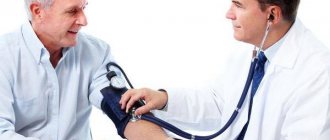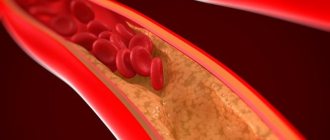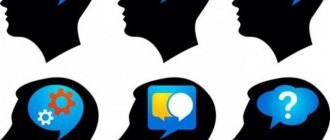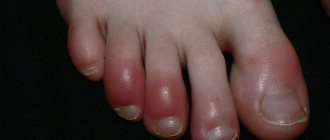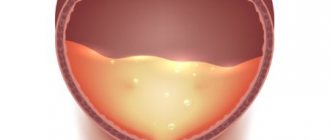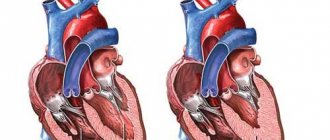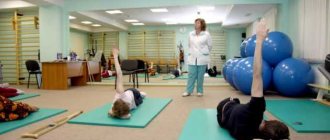Scientific editor: Strokina O.A., practicing therapist, functional diagnostics doctor. September, 2020
Arterial hypertension (hypertension, hypertension) is a condition in which blood pressure is equal to or exceeds 140 mm Hg. (as a result of at least three measurements taken at different times in a quiet environment; in this case, you should not take medications that either increase or decrease blood pressure).
If the causes of arterial hypertension can be identified, then it is considered secondary or symptomatic. In the absence of an obvious cause, it is called primary, or hypertension. The latter is much more common; more than 90% of people with high blood pressure suffer from it.
Arterial hypertension affects 30-45% of the adult population. Before the age of 50, the disease is more often observed in men, after 50 years – in women.
What is arterial hypertension
Arterial hypertension is a condition that is defined by a persistent increase in systolic pressure up to 140 mmHg. century or more; and diastolic pressure up to 90 mm Hg. Art. and more.
A disease such as arterial hypertension occurs as a result of disturbances in the functioning of blood pressure regulation centers. Another cause of hypertension is diseases of internal organs or systems.
Such patients have severe headaches (especially in the morning) in the occipital region, causing a feeling of heaviness and staleness in the head. In addition, patients complain of poor sleep, decreased performance and memory, as well as characteristic irritability. Some patients complain of pain in the chest, difficulty breathing after doing physical work, and blurred vision.
Subsequently, the increase in pressure becomes permanent, affecting the aorta, heart, kidneys, retina and brain.
Classification
There are essential hypertension, which remains the only disorder in the body and accounts for up to 80% of all cases of pathological increase in pressure, as well as secondary hypertension, which occurs against the background of other diseases.
How blood pressure affects blood vessels and what leads to the appearance of hypertension can be seen in the following video:
Among secondary hypertension there are:
- Hemodynamic (due to damage to large arteries and the heart).
- Neurogenic (develops as a result of diseases of the brain and the entire nervous system).
- Endocrinopathic (its cause is diseases of the pituitary gland, thyroid gland, adrenal glands).
- Nephrogenic (appears against the background of kidney pathologies).
- Medicinal (its occurrence is influenced by taking medications).
Kinds
Arterial hypertension can be primary or secondary (according to ICD-10). In approximately one in ten hypertensive patients, high blood pressure is caused by damage to an organ. In these cases we talk about secondary or symptomatic hypertension. About 90% of patients suffer from primary or essential hypertension.
WHO experts recommend additional classification of hypertension:
- no symptoms of internal organ damage;
- with objective signs of damage to target organs (in blood tests, during instrumental examination);
- with signs of damage and the presence of clinical manifestations (myocardial infarction, transient cerebrovascular accident, retinal retinopathy).
Primary
The essence of primary arterial hypertension is a sustained increase in blood pressure without an identified cause. Primary is an independent disease. It develops against the background of heart disease and is most often called essential hypertension.
Essential hypertension (or hypertension) does not develop as a result of damage to any organs. Subsequently, it leads to target organ damage.
It is believed that the disease is based on hereditary genetic disorders, as well as disorders of the regulation of higher nervous activity caused by conflict situations in the family and at work, constant mental stress, an increased sense of responsibility, as well as excess body weight, etc.
Secondary arterial hypertension
As for the secondary form, it occurs against the background of diseases of other internal organs. This condition is also called arterial hypertension syndrome or symptomatic hypertension.
Depending on the cause of their occurrence, they are divided into the following types:
- renal;
- endocrine;
- hemodynamic;
- medicinal;
- neurogenic.
According to the nature of the course, arterial hypertension can be:
- transient: a rise in blood pressure is observed sporadically, lasts from several hours to several days, normalizes without the use of medications;
- Labile: this type of hypertension is considered to be the initial stage of hypertension. Actually, this is not a disease yet, but rather a borderline state, since it is characterized by minor and unstable pressure surges. It stabilizes on its own and does not require the use of drugs that lower blood pressure.
- Stable arterial hypertension. Persistent increase in blood pressure, which requires serious supportive therapy.
- crisis: the patient experiences periodic hypertensive crises;
- malignant: blood pressure rises to high levels, the pathology rapidly progresses and can lead to severe complications and death of the patient.
Stages of disease development
During a diagnostic examination, the doctor not only makes a diagnosis of hypertension, but also determines the stage of development of the disease. There are 3 stages:
- at stage 1 of the development of hypertension, there is no damage to internal organs, and pressure indicators are at around 140 to 90, or 159 to 99;
- Stage 2 is characterized by a blood pressure value of 160 over 100, 170 over 109. Pressure surges are periodic, but stable. Drug therapy required;
- Stage 3 is the hardest. Blood pressure reaches the level of 180 over 100. Complications develop. The pathology is practically untreatable.
How to treat the pathology depends on the identified degree of arterial hypertension.
Causes
Blood pressure increases with age. About two thirds of people over 65 years of age have hypertension. People over 55 years of age with normal blood pressure have a 90% risk of developing hypertension over time. Because elevated blood pressure is common in the elderly, such “age-related” hypertension may seem natural, but elevated blood pressure increases the risk of complications and mortality.
The most common causes of hypertension are:
- Kidney diseases,
- Hypodynamia, or inactivity.
- Men are over 55 years old, women over 60 years old.
- Adrenal tumor
- Side effects of drugs
- Increased blood pressure during pregnancy.
- Hypodynamia, or inactivity.
- History of diabetes mellitus.
- Increased blood cholesterol (above 6.5 mol/l).
- High salt content in food.
- Systematic abuse of alcoholic beverages.
The presence of even one of the listed factors is a reason to start preventing hypertension in the near future. Neglecting these measures will most likely lead to the formation of pathology within several years.
Determining the causes of arterial hypertension requires ultrasound, angiography, CT, MRI (kidneys, adrenal glands, heart, brain), studies of biochemical parameters and blood hormones, and blood pressure monitoring.
Treatment of hypertension in diabetes mellitus
With diabetes, blood pressure increases in most patients, which complicates the course of the disease. The combination of high blood pressure and diabetes can lead to ischemia, stroke, kidney and heart pathologies.
Some antihypertensive medications may have a negative effect if diabetes is diagnosed. In case of diabetes mellitus, blood pressure parameters should not be allowed to reach 140 to 90. As the values increase, the course of diabetes becomes more complicated.
Drug therapy for hypertension in combination with diabetic pathology includes drugs in the following categories:
- diuretics . Diuretic compounds are prescribed with caution and taken under strict medical supervision;
- beta blockers . The prescription of a specific medicinal composition from this group depends on the course of diabetes mellitus;
- ACE inhibitors . This is Captapril, Berlipril.
During treatment, you must adhere to the diet recommended by your doctor. It is necessary to exclude salt, caffeine, sugar, and include carbohydrates and proteins in food.
Symptoms of arterial hypertension
As a rule, before various complications appear, arterial hypertension quite often occurs without any symptoms, and its only manifestation is an increase in blood pressure. In this case, patients have practically no complaints or they are non-specific, however, headaches are periodically noted on the back of the head or in the forehead, and sometimes they may feel dizzy and have noise in the ears.
Arterial hypertension syndrome has the following symptoms:
- Pressing headache that occurs periodically;
- Whistling or ringing in the ears;
- Fainting and dizziness;
- Nausea, vomiting;
- "Floaters" in the eyes;
- Cardiopalmus;
- Pressing pain in the heart area;
- Redness of the facial skin.
The described signs are nonspecific and therefore do not raise suspicion in the patient.
As a rule, the first symptoms of arterial hypertension make themselves felt after pathological changes have occurred in the internal organs. These signs are intermittent and depend on the affected area.
It cannot be said that the symptoms of hypertension in men and women are significantly different, but in fact, men are indeed more susceptible to this disease, especially in the age group from 40 to 55 years. This is partly explained by the difference in physiological structure: men, unlike women, have greater body weight, and accordingly, the volume of blood circulating in their vessels is significantly higher, which creates favorable conditions for high blood pressure.
A dangerous complication of arterial hypertension is a hypertensive crisis, an acute condition characterized by a sudden rise in pressure by 20-40 units. This condition often requires calling an ambulance.
What is hypertension?
Hypertension is a persistent increase in blood pressure of more than 139/89 mmHg in a calm state. In general, high blood pressure is the only damaging factor of this disease.
Hypertension affects men and women equally. The disease usually begins after 40 years of age. This is a very common pathology. It is called a disease of the autumn of life, although in recent decades hypertension has become much younger.
At the same time, people are often unaware of a serious problem; many attribute headaches to poor sleep or bad weather. Untreated high blood pressure can lead to stroke and heart attack.
You can hear two designations for the disease:
- arterial hypertension;
- arterial hypertension.
The first term is considered not entirely correct, since it literally means a persistent increase in pressure. Arterial hypertension is an increase in tone, that is, not necessarily an increase in blood pressure. Hypertension can also develop with a decrease in vascular tone. At the same time, both terms are constantly used in everyday life.
The value of blood pressure depends on peripheral resistance and vascular elasticity. When the receptors of the hypothalamus are irritated, renin-angiotensin-aldosterone hormones begin to be produced in larger quantities, which cause spasms of microvessels and arteries, thickening of their walls, and an increase in blood viscosity. This leads to the appearance of arterial hypertension, which becomes irreversible and stable over time. There are two forms of high blood pressure:
- Essential (primary). Accounts for 95% of cases of hypertension. The reason for the appearance of this form is a combination of different factors (heredity, poor environment, excess weight).
- Secondary. Accounts for 5% of cases of hypertension. High blood pressure in this form is caused by disturbances in the functioning of the body (kidney, liver, heart disease).
- ICD 10 code: I10 Essential (primary) hypertension
Blood pressure level (BP)
| Category | Systolic pressure (upper) | Diastolic pressure (lower) |
| Optimal pressure | <120 | <80 |
| Normal | 120-129 | 80-84 |
| High normal | 130-139 | 85-89 |
| Hypertension: | ||
| Level 1 (soft) | 140-159 | 90-99 |
| Grade 2 (moderate) | 160-179 | 100-109 |
| Grade 3 (severe) | >=180 | >=110 |
| Isolated systolic hypertension | >=140 | <90 |
- When measuring blood pressure, you are told two numbers. For example, 120/80. 120 is the upper pressure. It is also called systolic pressure.
- 80 is the lower pressure. It can also be called diastolic pressure. Accept the fact that both of these numbers are equally important to us.
The table shows that pressure lower than 120/80 is considered optimal. As a rule, with such indicators there is a minimal load on the body.
Please note that 139/89 is the limit of normal pressure. And if you have diabetes, then the border will already be shifted to 130/85.
Signs you should definitely pay attention to
What signs should you pay attention to and consult a doctor, or at least start measuring your blood pressure yourself using a tonometer and recording it in your self-monitoring diary:
- dull pain in the left side of the chest;
- heart rhythm disturbances;
- pain in the back of the head;
- periodic dizziness and tinnitus;
- deterioration of vision, appearance of spots, “floaters” before the eyes;
- shortness of breath on exertion;
- cyanosis of hands and feet;
- swelling or swelling of the legs;
- attacks of suffocation or hemoptysis.
Hypertension (hypertension) - what is it?
According to the currently accepted classification, arterial hypertension is an increase in blood pressure above 140/90 mm. rt. Art. Today, there are two forms of hypertension:
- primary (or essential, that is, the cause is unknown) - characterized by an increase in blood pressure for no apparent reason;
- secondary (symptomatic) - the cause of increased blood pressure is associated with any internal organs (liver, kidneys, lungs, brain, endocrine glands).
As the name implies, the cause of essential hypertension, despite all the achievements of modern medicine, is not clear, so the only traditional method of treatment remains eliminating high blood pressure with pills. And since pills only relieve the consequences without eliminating the cause, the relevance of hypertension is acutely felt in the modern world. However, a group of medical researchers led by physicist V.A. Fedorov developed a new concept for the development of hypertension, which explains the mechanism of the disease at the cellular level and is confirmed by numerous studies. We'll talk about this innovative approach.
Degrees of arterial hypertension: 1, 2, 3
The clinical picture of arterial hypertension is influenced by the degree and type of disease. In order to assess the level of damage to internal organs as a result of persistently elevated blood pressure, there is a special classification of hypertension, consisting of three degrees.
| AH degree | Pressure level |
| 1 | Blood pressure rises to 140-159_90-99 mmHg. st |
| 2 | Blood pressure rises to 160-170/100-109 mm Hg. Art.; |
| 3 | The pressure rises to 180/110 mm Hg. Art. and higher. |
1st degree
At the first stage, there are no objective symptoms of target organ disorders: heart, brain, kidneys.
2nd degree arterial hypertension
The second degree of the disease comes with systematic and persistent surges in blood pressure, the patient needs rest, drug treatment, and hospitalization.
3rd degree hypertension
Systolic is above 180 mm Hg, diastolic is above 110 mm Hg. Grade 3 is considered a severe form, the pressure is stably at the level of pathological indicators, occurs with severe complications, and is difficult to correct with medications.
Traditional treatment methods
There are many folk techniques that help reduce blood pressure readings. Any home recipes can be used only after consulting a doctor. But this does not mean that you need to stop taking medications. It is necessary to continue medical therapy. Traditional methods are a complement to drug treatment.
Several recipes for high blood pressure:
- Take motherwort tincture 4 times a day for a month. Then a break for 10 days;
- Pour crushed walnut partitions (a glass) with chilled boiled water (2 glasses). Leave in the sun for 12 days. Strain, drink 1 tsp 1 time per day;
- squeeze the juice from the beets, drink 0.5 cups once a day. Course 4 days. Squeeze the juice in the evening, keep in the refrigerator, drink, diluting with hot water;
- orange (2 pieces) and 1 lemon. Grind fruits with peels in a meat grinder. Add 0.5 liters of crushed cranberries and honey (0.5 cups) to the mixture. Morning and evening drink 1 tbsp. l.
Using folk remedies, it is necessary to monitor your well-being and control blood pressure parameters.
How does arterial hypertension occur in children?
Arterial hypertension in children is much less common than in adults, and remains one of the most common chronic diseases in pediatrics. According to various studies, the incidence of this pathology among children and adolescents ranges from 1 to 18%.
The causes of childhood and adolescent hypertension usually depend on the age of the child. Most of the pathology is caused by kidney disorders.
Uncontrolled excessive intake of drugs from the group of adrenergic agonists can increase blood pressure. These include naphthyzin and salbutamol.
Risk factors for developing arterial hypertension include:
- constant psycho-emotional stress, conflict situations in the family and school;
- the child’s personal characteristics (anxiety, suspiciousness, tendency to depression, fear, etc.) and his reaction to stress;
- excess body weight;
- metabolic features (hyperuricemia, low glucose tolerance, imbalance in the ratio of cholesterol fractions);
- excessive consumption of table salt.
Prevention of arterial hypertension should be carried out at the population and family levels, as well as in risk groups. First of all, prevention consists of organizing a healthy lifestyle for children and adolescents and correcting identified risk factors. Basic preventive measures must be organized in the family: creating a favorable psychological atmosphere, proper work and rest schedule, nutrition that helps maintain normal body weight, adequate physical (dynamic) exercise.
Prevention
The development of arterial hypertension can be avoided. To do this, it is necessary to follow the basic rules of primary prevention. Doctors have also developed rules for secondary prevention aimed at preventing complications in those who already suffer from arterial hypertension.
Primary prevention includes the following measures:
- limiting the intake of fast carbohydrates, spicy, spicy foods, animal fats;
- reducing salt intake;
- reducing alcohol consumption to a minimum dose;
- introducing fresh vegetables, fruits, and foods containing unsaturated fats into the diet;
- exclusion of stressful situations;
- balancing rest and work;
- giving up bad habits (drugs, tobacco);
- increasing physical activity.
Secondary prevention is represented by the following points:
- compliance with the instructions of the attending physician;
- taking all medications prescribed by a specialist in the specified dosage;
- blood pressure control (systematic). You need to measure your blood pressure twice a day (morning, evening);
- excess weight loss;
- eliminating completely bad habits;
- performing physical activity daily for 30 minutes.
Did you like the article? Save it!
Still have questions? Ask them in the comments! Cardiologist Mariam Harutyunyan will answer them.
Ivan Grekhov
Graduated from the Ural State Medical University with a degree in General Medicine. General practitioner
Complications and consequences for the body
One of the most important manifestations of hypertension is target organ damage. Patients with arterial hypertension usually die at an early age. The most common cause of death among them is heart disease. Stroke and kidney failure are common, especially in people with severe retinopathy.
The most significant complications of arterial hypertension include:
- hypertensive crises,
- cerebrovascular accidents (hemorrhagic or ischemic strokes),
- myocardial infarction,
- nephrosclerosis (primarily shriveled kidney),
- heart failure,
- dissecting aortic aneurysm.
Symptoms of hypertension
What is arterial hypertension, what do tonometer readings look like in this condition? We can talk about increased blood pressure when the values exceed 140 to 90. This happens to every person at least once in their life.
The cause of a one-time increase in blood pressure may be the release of adrenaline caused by strong emotional arousal. Emotions can be both negative and positive. But in such a situation, the body copes on its own, and the pressure normalizes without the effect of medications. Such cases occur during the daytime, but by evening everything returns to normal. But if the pressure rises regularly and does not return to normal on its own, then this is already progressive hypertension, which requires treatment and constant monitoring.
The clinical picture of hypertension in the initial stages may not be clearly expressed. A person may not even be aware of high blood pressure and processes developing in blood vessels for a long time. Early and first signs of hypertension are irritability for no apparent reason and increased fatigue.
Symptoms of hypertension in the early stages: neurotic disorders, weakness, sleep disturbances, noise and ringing in the ears and dizziness, rapid heartbeat.
Lack of treatment leads to deterioration of health and the disease manifests itself with increased symptoms:
- constant headaches;
- dizziness;
- the heartbeat becomes faster or, on the contrary, weak;
- the face takes on a reddish tint;
- anxious and constantly tired state;
- excessive sweating;
- swelling of the face and body, especially after sleep;
- “flies” before the eyes;
- memory impairment.
If such symptoms appear periodically, this is not a reason to relax and not undergo a medical examination.
Symptoms in later stages
In the later stages of the disease, all of these symptoms intensify and become permanent. Besides:
- memory and intelligence are significantly reduced,
- coordination is impaired
- gait changes
- sensitivity decreases,
- weakness appears in the arms and legs,
- vision deteriorates.
If you do not adjust your lifestyle and do not start treatment, the disease will progress, wearing out the heart, causing severe and irreversible damage to target organs: the brain, kidneys, blood vessels, fundus.
If the listed ailments do not bother you constantly, but only from time to time, and after rest they completely recede for some time, this may still be a sign of hypertension.
When the first symptoms appear, the situation should be adequately assessed. If the patient is conscious, blood pressure should be measured in both arms. If it exceeds 180/110 mmHg. Art. You should immediately call a team of doctors, and if necessary, provide first aid: lay the patient on his side, provide an influx of fresh air, if he loses consciousness, give him a sniff of ammonia, give a sedative (Corvalol, Valocordin).
Diagnostics
Diagnosis of arterial hypertension is carried out based on the results of changes in blood pressure. History, physical examination and other research methods help identify the cause and clarify target organ damage.
Diagnosis of arterial hypertension is based on the following types of examination:
- ECG, glucose test and general blood test;
- Ultrasound of the kidneys, determination of the level of urea, creatinine in the blood, general urine analysis - are carried out in order to exclude the renal nature of the formation of the disease;
- Ultrasound of the adrenal glands is advisable to perform if pheochromocytoma is suspected;
- hormone analysis, ultrasound of the thyroid gland;
- MRI of the brain;
- Consultation with a neurologist and ophthalmologist.
When examining the patient, lesions are revealed:
- kidneys: uremia, polyuria, proteinuria, renal failure;
- brain: hypertensive encephalopathy, cerebrovascular accident;
- heart: thickening of the cardiac walls, left ventricular hypertrophy;
- vessels: narrowing of the lumen of arteries and arterioles, atherosclerosis, aneurysms, aortic dissection;
- fundus: hemorrhages, retinopathy, blindness.
Causes of hypertension
The causes of hypertension include the following factors:
- renal pathologies;
- insufficiently active mobility;
- age in the range from 55 to 60 years and older;
- side effect caused by medications;
- in pregnant women in the early and late stages;
- diabetes;
- atherosclerosis;
- increased cholesterol levels;
- eating a lot of salt;
- drinking alcohol in excessive doses.
To find out the reason that provoked the development of hypertension in an adult patient, a diagnosis of arterial hypertension is carried out. The study includes ultrasound diagnostics, MRI, hormone testing, and blood pressure monitoring.
Having understood the causes of the pathology, and knowing what arterial hypertension is, let’s consider the symptoms and treatment of the disease.
Treatment
Normalizing blood pressure levels and correcting the influence of risk factors help to significantly reduce the likelihood of complications from internal organs. Therapy includes the use of non-drug and drug methods.
For treatment and examination for hypertension, you need to see a doctor. Only a specialist, after a full examination and analysis of the examination results, will be able to correctly diagnose and prescribe competent treatment.
Non-drug treatments
First of all, non-drug methods are based on changing the lifestyle of a patient suffering from arterial hypertension. It is recommended to avoid:
- smoking, if the patient smokes;
- consumption of alcoholic beverages, or reducing their intake: for men up to 20-30 grams of ethanol per day, for women up to 10-20, respectively;
- increased consumption of table salt with food, it must be reduced to 5 grams per day, preferably less;
- a diet limiting animal fats, sweets, salt and liquids if necessary;
- using medications containing potassium, magnesium or calcium. They are often used to reduce high blood pressure.
Medicines for arterial hypertension
Drug therapy should be prescribed taking into account the following recommendations:
- Treatment begins with small doses of drugs.
- If there is no therapeutic effect, it is necessary to replace one drug with another.
- The interval between degrees should be less than 4 weeks, provided that a rapid decrease in blood pressure is not required.
- The use of long-acting medications to obtain a 24-hour effect with a single dose.
- Application of optimal combination of devices.
- Therapy should be permanent. It is not allowed to use the drug in courses.
- Effective blood pressure control throughout the year helps to gradually reduce the dose and amount of medications.
It is recommended to constantly change medications prescribed by a specialist for arterial hypertension, alternating analogues. Otherwise, an addiction effect is observed when a productive drug for cardiac hypertension is no longer able to stabilize normal blood pressure.
What measures should the patient take?
Non-drug treatment is the basis of hypertension therapy. The fact is that special medications can only reduce blood pressure for a certain period of time, while adherence to a special lifestyle can significantly slow down the progression of the disease and reduce the required dosage of medications.
The main measures that the patient should take with the approval of the doctor include:
Diet food
Salt and animal fats are wisely limited, and the presence of potassium and calcium in the diet increases. If the patient reduces his weight, this will undoubtedly lead to a drop in blood pressure levels.
Physical activity
The doctor will recommend available sports, including swimming, skiing, and light running. Even if there are contraindications to intense exercise, most patients can do leisurely walking or simple exercises. High blood pressure is the result of drinking alcohol and smoking, so for your own health you will have to give up bad habits.
Water treatments
Contrast showers and water sports are especially useful for hypertensive patients. Methods of relaxation, calming, and reducing the harmful effects of stress (massage, relaxation, some physiotherapeutic techniques) are also an important part of non-drug therapy for hypertension.
Timely and regular visits to your doctor
Examinations for hypertension are necessary to monitor the condition of the heart, blood vessels, kidneys and, if necessary, to adjust drug doses.
Nutrition
Along with lifestyle, special attention in the prevention of arterial hypertension is given to nutrition. You need to eat more natural foods, without any additives or preservatives (if possible). The menu should contain a sufficient amount of fruits, vegetables, and unsaturated fats (linseed oil, olive oil, red fish).
The diet of a patient with hypertension must include fiber. It is this that helps lower cholesterol levels in the blood and prevents its absorption. Therefore, it is worth eating more fruits and vegetables.
If you are overweight, you need to reduce your daily caloric intake to 1200-1800 kcal.
What is better to avoid if you have arterial hypertension:
- fish and fatty meats, store-bought sausages, canned food, smoked meats, lard, cheese;
- margarine, pastry cream, butter in excess (butter can be spread on bread in a thin, transparent layer);
- sweets (cakes, cookies, candies, sugar, pastries);
- alcoholic drinks, strong tea (this applies to both green and black tea), coffee;
- too salty, spicy, fatty foods;
- store-bought mayonnaise, sauces and marinades;
Classification of hypertension
To choose the optimal treatment tactics, you must first determine the type of this pathology.
According to etiology, it is customary to distinguish:
- primary hypertension (also called idiopathic or essential);
- symptomatic hypertension (due to other pathologies or taking certain medications).
According to the nature of its course, hypertension is divided into:
- benign (gradually progressive form, including 3 stages);
- malignant (severe, usually of endocrine etiology).
The benign form, which is diagnosed in most cases, is characterized by gradual development with damage to certain organs.
The malignant form is relatively rare and can be detected even in childhood. It is characterized by persistently high blood pressure and severe complications. Decompensated heart failure, hypertensive encephalopathy and a sharp impairment of the functional activity of the kidneys often develop.
According to the degree of increase in blood pressure, the following are distinguished:
- mild hypertension (blood pressure readings are not higher than 140/90, medication is usually not required);
- moderate form (stages 1-2, pressure up to 180/110 mm Hg);
- severe hypertension (stage 3 or malignant form).
Please note: The terms “mild” and “severe” speak only about blood pressure numbers, but not about the general condition.
Experts distinguish three stages of hypertension with a benign course:
- 1st (preclinical) stage of hypertension. Moderate headaches and less pronounced sleep disturbances may occur. Blood pressure does not increase above 140-160/95-100 and decreases after proper rest.
- Stage 2 hypertension. There is a narrowing of the arteries and hypertrophy of the left ventricle of the heart. Blood pressure is higher and remains stable, and at rest the numbers reach 160-180/100-110 mm. rt. Art. Laboratory tests reveal increased levels of creatinine in the blood and protein in the urine.
- Stage 3 hypertension. Angina pectoris, impaired cerebral blood flow, hemorrhages in the fundus, and dissection of the aortic walls develop. In this case, the risk of developing heart attacks, strokes and vision loss is especially high.
Please note: some patients may experience the so-called. "White coat hypertension" With it, symptoms appear only in the presence of medical workers.
A special form of pathology is hypertensive crises . This is an extreme manifestation of the disease, which is characterized by a sharp increase in blood pressure to critical levels. A serious condition with intense headache, nausea and vomiting can persist for up to a day. Due to impaired cerebral blood flow, intracranial pressure increases. Depending on the mechanism of blood pressure increase, eukinetic, as well as hypo- and hyperkinetic crises are distinguished.
Important: in case of a hypertensive crisis, it is important to provide the patient with first aid and urgently call an ambulance.
Hypertension can be isolated systolic or diastolic. With this form, there is an increase in only the “upper” or only the “lower” numbers of blood pressure.
Refractory hypertension is usually understood as a form of the disease in which therapy using three or more pharmacological agents is ineffective.
Recommendations for patients with arterial hypertension
What a patient with hypertension should know and do:
- maintain normal weight and waist circumference;
- exercise regularly;
- eat less salt, fat and cholesterol;
- consume more minerals, in particular potassium, magnesium, calcium;
- limit the consumption of alcoholic beverages;
- stop smoking and using psychostimulants.
Hypertonic disease
Hypertension (essential arterial hypertension, primary arterial hypertension) is a chronic disease characterized by a long-term persistent increase in blood pressure.
The diagnosis of hypertension is usually made by excluding all forms of secondary hypertension. According to the recommendations of the World Health Organization (WHO), blood pressure is considered normal if it does not exceed 140/90 mm Hg. Art. Exceeding this indicator over 140–160/90–95 mm Hg. Art. at rest when measured twice during two medical examinations indicates the presence of hypertension in the patient.
Hypertension accounts for approximately 40% of the total structure of cardiovascular diseases. It occurs with equal frequency in women and men, and the risk of development increases with age.
Timely, properly selected treatment of hypertension allows you to slow down the progression of the disease and prevent the development of complications.
Forecast
The higher the blood pressure and the more pronounced changes in the retinal vessels or other manifestations of target organ damage, the worse the prognosis. The prognosis depends on pressure indicators. The higher its indicators, the more pronounced the changes in blood vessels and internal organs.
When diagnosing arterial hypertension and assessing possible consequences, specialists mainly rely on upper blood pressure readings. If all medical prescriptions are followed, the prognosis is considered favorable. Otherwise, complications develop that make the prognosis questionable.
Treatment of arterial hypertension
The criteria for the effectiveness of treatment of hypertension is the achievement of:
- short-term goals: maximum reduction in blood pressure to a level of good tolerance;
- medium-term goals: preventing the development or progression of changes in target organs;
- long-term goals: prevention of cardiovascular and other complications and prolongation of the patient’s life.
Medications
Several systems regulate blood pressure (BP) in the body, and blood pressure-lowering medications exert their therapeutic effects by influencing the functions of these systems.
- If the cause of hypertension is water and salt retention in the body, it is advisable to use blood pressure pills with a diuretic effect - diuretics.
- For disorders in the renin-angiotensin-aldosterone system (RAAS), which regulates blood pressure using a hormone called angiotensin II, blockers of this hormone receptors - sartans - are used.
- To reduce the load on the heart muscle and peripheral vascular resistance, normalize blood circulation and metabolism, blockers of the enzyme that converts angiotensin I into angiotensin II or ACE inhibitors are used.
- To reduce the oxygen demand of the heart muscle, calcium channel blockers are relevant, preventing the leakage of Ca ions into its cells - CCBs, also called calcium antagonists.
- If a direct effect on the central nervous system is necessary, centrally acting drugs are used that affect the receptors responsible for maintaining normal blood pressure.
- For concomitant hypertension pathologies such as atrial fibrillation or coronary artery disease, the use of beta-blockers is recommended.
In treatment regimens for hypertension, combinations of antihypertensive drugs with different pharmacodynamics are often practiced.
Any hypertensive crisis requires drug treatment. Therapeutic intervention in the event of a crisis involves combining several pharmaceutical drugs and providing immediate assistance to the victim.
Antihypertensive medications can be taken only for the gradual relief of hypertensive crises that are not accompanied by any complications.
Here are some drugs that can help stop a hypertensive crisis:
- Nifedipine – the tablet dissolves under the tongue, the effect is observed for about 5 hours;
- Beta-blockers - drugs such as atenolol and esmolol are taken if it is necessary to artificially regulate the work of the sympathetic nervous system (when a hypertensive crisis occurs against the background of a low heart rate);
- Captopril - taken from 10 to 50 mg orally, the effect of the drug lasts about 5 hours;
- Diuretics - furosemide in the treatment of hypertensive crises should be administered intravenously at a dose of 1 mg/kg body weight. The drug has varying effectiveness depending on the individual reaction of the body, so the doctor can increase the dose to 12 mg/kg body weight;
- Vasodilators - for example, sodium nitroprusside is able to block nitric oxide in the wall of blood vessels, due to which relaxation of the arteries is observed.
Medicines for relief of hypertensive crisis:
- Captopril 10-50 mg orally. The duration of action of the product lasts up to 5 hours;
- Nifedipine – taken under the tongue. The duration of action of the product is about 5 hours.
- Beta-blockers (atenolol, esmolol) are used for hypertension to normalize the tone of the sympathetic nervous system. They are used when a rise in blood pressure is combined with a decrease in heart rate;
- Vasodilators (sodium nitroprusside, hydralazine);
- Diuretics (furosemide).
Simple, affordable and priority measures for hypertension
These measures are based on lifestyle adjustments and elimination of risk factors:
- Diet.
- Reducing salt intake. Salt retains water in the body and increases its content in the blood, which leads to an increase in blood volume and, accordingly, increased stress on the kidneys.
- Reducing the consumption of easily digestible carbohydrates (sugar, sweet flour products). Sugar also promotes water retention and increases its content in the blood, and foods that lead to obesity lead to an increase in body weight, and, therefore, the number of blood vessels and, accordingly, blood volume.
- Exclusion of “unhealthy”, fatty, fried foods, fast food, etc. These products lead to “clogging” of the body, the load associated with their processing and excretion from the body increases, which also partly falls on the kidneys.
- Rejection of bad habits. Smoking and alcohol really kill, incl. contributing to the development of hypertension.
- Elimination of stressful situations.
- Increasing physical activity during the day (!):
- Increasing the share of safe physical labor (without overexertion and excessive stress on the spine and joints).
- Physical education: walking, swimming, exercise therapy, yoga, etc.
Treatment of hypertension without drugs
So, if the initial stage of the disease arterial hypertension is detected, how to treat the patient without resorting to medications? Since bad habits contribute to the development of the disease, first of all, when diagnosing hypertension, treatment methods will be as follows:
- If you are overweight, you need to take measures to reduce it, possibly with the help of a nutritionist. Studies show that overweight people who suffered from hypertension in 60% of cases after losing weight do not feel the need to take medications;
- Control of medications taken: dietary supplements, hormone-containing drugs, including oral contraceptives. Arterial hypertension while taking contraceptive medications is not at all uncommon, therefore, at the beginning of the course and throughout it, experts advise monitoring blood pressure readings on a regular basis, and if they increase, choosing other methods of protection;
- In the absence of contraindications, it is necessary to enrich the daily diet with foods containing fiber, as well as vitamin C. Research scientists have proven that a lack of vitamin C is one of the factors predisposing to high blood pressure;
- Elimination of foods and drinks that cause nervous excitement and increased blood pressure (caffeine-containing drinks increase blood pressure by 5 or more points after drinking an average cup of coffee, not to mention tonic drinks, medications, etc.);
- Reducing the amount of salt in food, both added during the cooking process and already present in semi-finished products, canned food, baked goods and factory-made products. Sodium levels need to be closely monitored;
- Stop smoking, both active and active;
- An active lifestyle, increasing the amount of physical activity during the day: walking instead of traveling by transport, walking while relaxing instead of watching TV, exercising in the morning, swimming in the pool help not only keep the body in good shape, but also strengthen the walls of blood vessels;
- Remove foods high in fat and cholesterol from your diet;
- Add foods high in magnesium: Studies have shown that 85% of people with hypertension are deficient in magnesium, and magnesium correlates with calcium absorption, which directly affects blood pressure levels. Such products include cabbage, baked potatoes, seafood, dairy products (cottage cheese, milk), meat, fish, poultry, eggs, seeds, nuts, dried fruits, dark chocolate, etc. If necessary, the doctor may prescribe magnesium supplements orally or in the form of injections;
- Avoid alcohol-containing drinks, including beer;
- The duration of sleep for symptoms of arterial hypertension should be at least 7-8 hours a day. It is advisable to get up and go to bed at the same time every day; it is recommended to change the nature of your work: limit frequent business trips and night shifts;
- Stress is one of the main factors that provoke an increase in blood pressure, so patients with hypertension are recommended to master psychological relaxation methods: meditation, self-hypnosis, auto-training. It is important to learn to see the positive sides of things and work on your character, react less expressly to stimuli, reducing the likelihood of an increase in blood pressure in response to conflict situations or unpleasant news.
In fact, as with any other disease, the primary purpose is to normalize lifestyle. In the case of symptoms of arterial hypertension, this is especially important, regardless of the person’s age.
Cardiovascular diseases and a decrease in the tone of arterial walls are observed today even in 30-year-old people, and the increase in the diagnosis of “arterial hypertension” begins at the age barrier of 40 years. Therefore, no matter how trite it sounds, a healthy lifestyle should begin in childhood. By establishing healthy eating habits at an early age, instilling active recreation as opposed to sitting at the computer, and promoting through their behavior abstinence from alcohol and nicotine abuse, parents are doing both themselves and their children a great service in preventing future diseases, including hypertension.
In addition to a healthy lifestyle, experts also have unusual advice for those diagnosed with hypertension. How to treat? Not only with medications, changing your diet and giving up bad habits, but also in such amazing ways as:
- Get an animal. Firstly, it adds much-needed physical activity, especially if the animal is an inquisitive puppy, and secondly, according to research, cats and dogs in direct contact help to calm down, relieve stress, and lower blood pressure.
- Laugh more. Laughter not only improves your mood, watching a comedy, reading jokes, accompanied by laughter, help saturate the body with energy, promote a light vibration massage of internal organs, improve blood circulation, and relax muscle tissue.
The first signs of hypertension
The latent course of hypertension or the initial stage of the disease can be suspected if the following are periodically observed:
- headache;
- unmotivated feeling of anxiety;
- hyperhidrosis (increased sweating);
- chilliness;
- hyperemia (redness) of the skin of the facial area;
- small spots before the eyes;
- memory impairment;
- low performance;
- irritability for no reason;
- swelling of the eyelids and face in the morning;
- rapid heartbeat at rest;
- numbness of fingers.
These symptoms may occur regularly or occur quite rarely. One cannot but attach importance to them, since the disease is very insidious. These clinical manifestations require urgent lifestyle changes, since correction not carried out in a timely manner leads to fairly rapid progression of the disease. As the pathology develops, the list of constant symptoms of hypertension expands. Impaired coordination of movements and decreased visual acuity are added.
